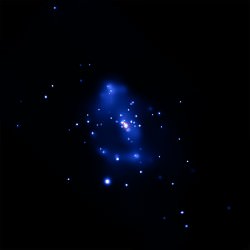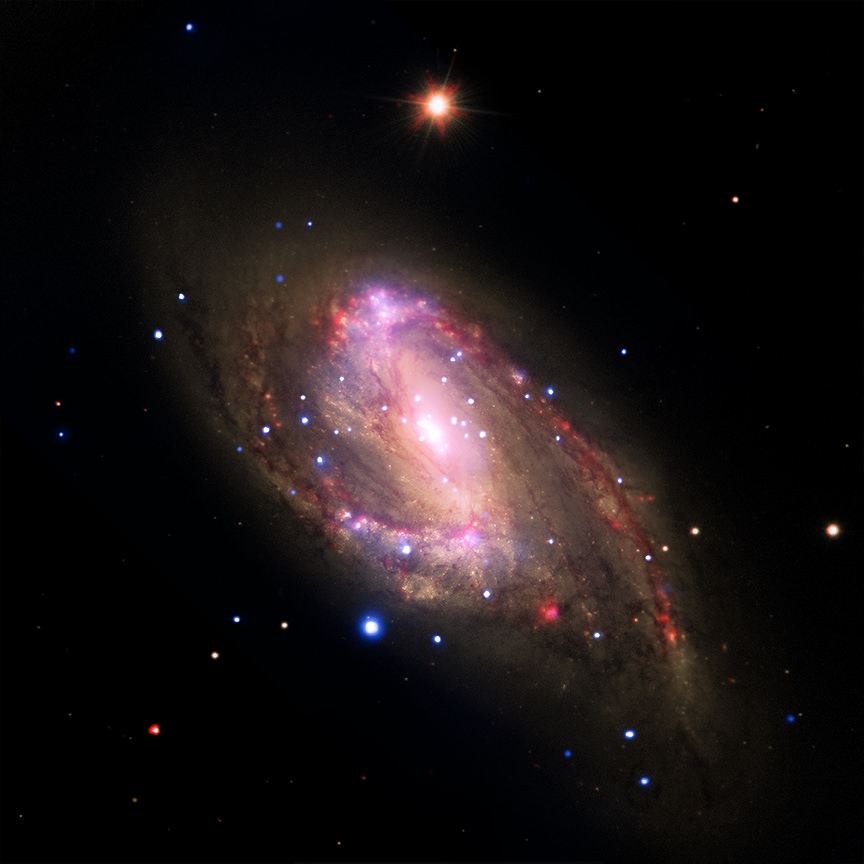NGC 3627 glows in the combined light of Hubble, Chandra, Spitzer and the Very Large Telescope in this image. Astronomers conducted a survey of 62 galaxies, including NGC 3627 to study monster black holes at their centers.
It’s not just pretty, it’s science. Like a starry watercolor, astronomers combining light from Earth and space-based observatories found 37 new supermassive black hole candidates lurking in nearby galaxies.
Included in that survey is NGC 3627 pictured above. Astronomers combined X-ray data from NASA’s Chandra X-ray Observatory, infrared data from the Spitzer Space Telescope, and optical data from the Hubble Space Telescope and the Very Large Telescope. The other images give the galaxy context but it’s the ghostly blue images from Chandra that show super bright in the X-ray images; X-ray light powered by material falling into a monster black hole.
 Gas and dust slowly spins around the black hole creating a flattened disk, or accretion disk. As material falls inward, it heats up and releases large amounts of energy that shine brightly in the ultraviolet region of the spectrum.
Gas and dust slowly spins around the black hole creating a flattened disk, or accretion disk. As material falls inward, it heats up and releases large amounts of energy that shine brightly in the ultraviolet region of the spectrum.
NGC 3627, located about 30 million light-years from Earth, was just one of a survey of 62 nearby galaxies using archived data from Chandra and data from the Spitzer Infrared Nearby Galaxy Survey. Of those, 37 galaxies contained bright X-ray sources, indicating active black holes at their cores. Scientists believe that seven of those sources are new supermassive black hole candidates.
The paper describing the survey results was published in the April 10, 2011 issue of The Astrophysical Journal.
Combining ultraviolet and infrared observations confirm previous Chandra results that found that there may be many more galaxies powered by monster black holes than believed previously through optical surveys. Scientists say in the paper that low-levels of black hole activity previously may have been hidden by dust or washed out by the bright light of the galaxy.
Image caption: Bright X-ray sources glow a ghostly blue in this image in NGC 3627 from NASA’s Chandra X-ray Observatory. A study confirms previous Chandra results that indicate that more galaxies powered by monster black holes populate the cosmos.


As soon as I looked at the top image I thought, “Yes!! I can see a blackhole!!” then I scrolled and it turned out to be a speck of dust on my monitor right in the center of the galaxy…. lol.
SMBHs seem to be universal with galaxies. The size of these SMBHs also determines the rate of star burst activity. There is then probably a sort of Goldilocks range for the size of these BHs. If they are too big there is too much star burst activity for stable planetary systems. If the BHs are too small too few planetary systems may be formed.
LC
I certainly understand that the study of SMBHs at the centers of galaxies is in its infancy, and there is need for much further study and confirmation, but don’t we have enough evidence by now to suggest strongly that SMBHs are more the rule rather than the exception, at least in spiral galaxies? It seems to me that at this point it would be more newsworthy and scientifically interesting if it were discovered that there wasn’t a SMBH in a galaxy than that there was.
Recently, I did not give whole lot thought to commenting on weblog
articles and have left feedback even less. Viewing your useful piece of
writing, might inspire me to do this again.